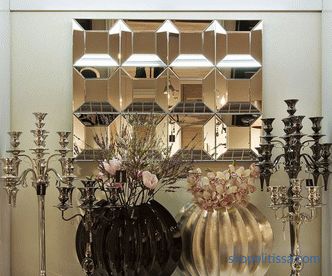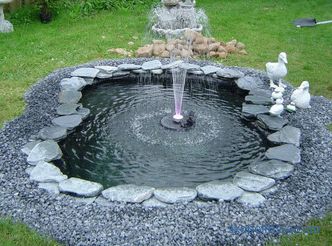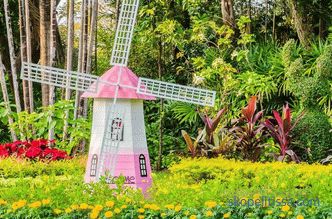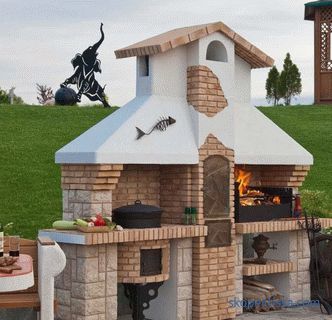Get an impressive landscape, limiting the minimum amount of work possible by choosing for the garden landscape design in the style of minimalism. The article describes the origins and main features of the style, the materials used and the preferred color scheme. You will get acquainted with the features of the site layout, key details and garden plants, learn about modern styles.
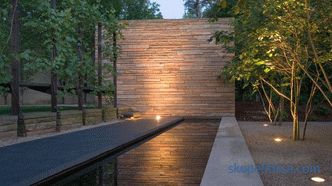
On the Origins of the Style
Minimalism in Landscape Design was the result of the architectural avant-garde that originated 20th century, when, at the same time with great social shifts, the methods of creativity began to change rapidly. In contrast to the luxury of past epochs, new principles formed the basis for new trends: clarity of form, concreteness of ideas, limited color palette.
The first avant-garde trends - constructivism and functionalism abandoned classical canons and traditional materials. Minimalism, which was formed a little later, retained their compositional brevity, but at the same time, departed from excessively strict rationality, and therefore could spread - first in architecture and interior design, and then in landscape design.
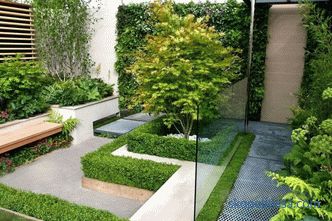
Another factor contributing to the spread of minimalism techniques in the design of suburban areas is related to its versatility. If the backyard territory has a modest size, it is not easy to find the appropriate style of the plot; minimalism not only fits into a small space, but also visually expands it. On a large plot, creating an integral composition using this style is much more difficult; scattered over a vast area of plants can cause a feeling of emptiness, excess space.
Style features
Minimalism is recognized by the following features:
-
Spaciousness . Strict selection of parts creates a feeling of airiness of space.
-
Planning . Zones stand out quite clearly. At the same time, strict adherence to symmetry during zoning is not required; often they refuse it altogether.
-
Simplicity and geometric completeness of the lines.
-
Refusal of excess diversity . This applies to everything: plants, small architectural forms, garden decor, color and furniture.
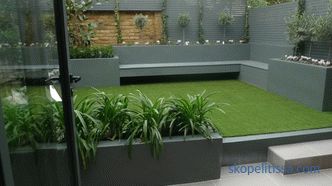
-
Pass-through zoning . Unlike other style trends, the plot is divided into zones conditionally and resembles a studio apartment. For zoning using simple tools that do not visually separate the territory - gabions, containers with flowers or paths. A good way is separation using elevation differences, for which flooring is ideal.
-
Content . At one time, in the ideas of modernism, the house and the space around it was called the “machine for housing”. This view has not lost relevance; in such a garden looks good swimming pool, sports field or tennis court. They are trying to be placed in a conspicuous place, often near housing.
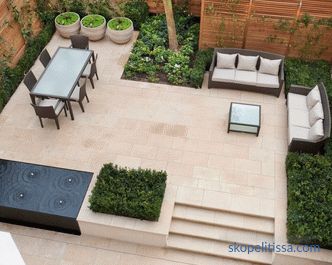
Materials and colors
A sign of high-quality design is using only a minimum (ideally one or two) materials, finishing should not be catchy. The color palette is also different modesty. Except for greenery, the main colors of the garden are shades of natural wood, white, gray and sand. For plants, a bluish-silver (in conifers) is added, as well as two or three bright shades: blue, purple, and orange. The following materials are used for gardening:
-
Concrete . The layout of the site in the style of minimalism rarely does without this material. It is most convenient to use it for arranging playgrounds or patios.
-
Paving materials . Large slabs, natural stone, pebbles are used not only for paving, but also as an alternative to concrete.
-
Wood . It is used to create spectacular sites (there are usually several). If the base of the site is wooden flooring, then the path leading to it is made of the same tree.
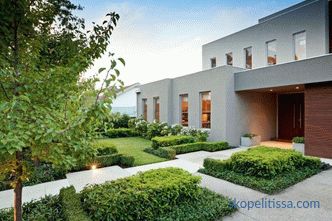
On our site you can find contacts of construction companies that offer landscaping services works You can directly communicate with representatives by visiting the low-rise country exhibition.
-
Gravel . Gravel dumping becomes an independent decorative element. It can be used to design tracks, patios, and entrances.
-
Metal and glass . Most often they are present as part of fences, street lamps or decorative accessories.
-
Non-glazed ceramics .Geometrical (cubic) flower containers are made not only of steel and cement, but also of this modest material.
Features of garden planning
The main task of the garden in the style of minimalism is the preservation of spaciousness. This means that all massive details are excluded from the design; To make the site look holistic, use the following techniques:
-
Tracks . A way of combining spaces that should not be abused. With its shape, the tracks remind that in this style smooth lines are not welcome.
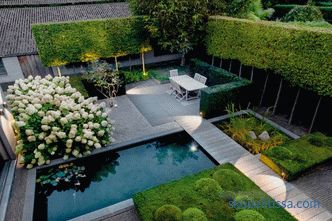
On our site you can find contacts of construction companies that offer construction services small architectural forms. You can directly communicate with representatives by visiting the low-rise country exhibition.
-
Zoning . Best of all, when zoning can be organized at the expense of the natural difference (albeit small) heights. If the plot is flat, the relief drop can be organized independently (or you can do without it).
-
Clear shapes and lines . When organizing space, they try to achieve conciseness: the plants are planted in a line, there are practically no round flowerbeds.
-
Simplification . In minimalism, it is customary to combine buildings to reduce the workload of space (for example, a gazebo and barbecue). The number of outbuildings should be reduced to a minimum.
About the ideas of minimalism in the garden in the following video:
5 key elements of the garden
Minimalism in the design of the suburban area is manifested in the use of the following elements:
-
Podiums and patios . Multi-level platforms and floorings are a characteristic sign of style. Depending on the location, they are connected using a staircase of several steps or a walkway. In choosing the form and location of the steps, one can show imagination: the classical rectangular, more daring triangular and rhomboid, spiral-shaped and fan-diverging steps are allowed. The main focus is not on color and material (ideally using one material for all elements), but on shape and size.

-
Pond . Extremely useful detail. We'll have to give up the desire to install on the site a classic fountain or a fancy pool; you will have to forget about the picturesque lake. The minimalist reservoir has the correct form (rectangular, round, square) with accurate outlines. The adornment of such a design is emphasized man-made appearance and expressive simplicity. The pond can be flush with the floor or be raised, decorated with a water cascade.
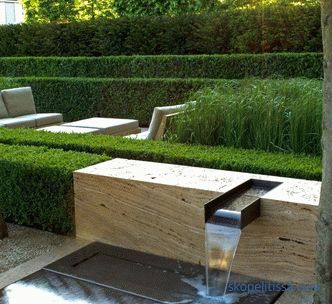
It might be interesting! In the article next link read about the projects of houses in the style of minimalism.
-
Small architectural forms . As a shelter from sunlight or an occasional rain, a simple canopy or arbor with glass walls is constructed. The rest of the buildings - supports for plants, lamps, benches - are also concise in form.
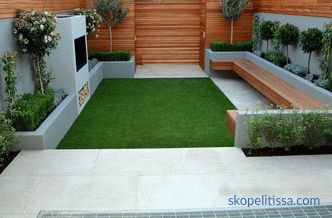
-
Decor . Minimalism in landscape design allows the use of a small number of decorative parts, which, however, is compensated by their thoughtful arrangement. Abstract sculptures in the form of balls, cubes and other geometric figures, installations using wire, mirrors and bamboo are capable of decorating the garden. Other landscape details serve as decorations - a raised reservoir and massive containers with plants.
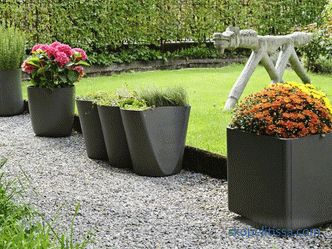
-
Garden furniture . All garden furniture is characterized by a simple, devoid of grace form. Allowed two types of furniture. On recreation areas, light monochromatic objects made of plastic, steel or aluminum will harmoniously look. In the garden, a simple wooden bench or gabion with a wooden top fixed on top will be ideal.
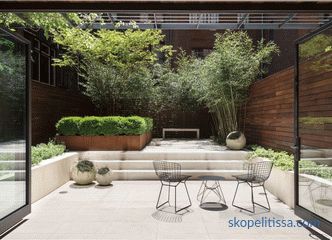
Plants of the style
Plants in this area do not quite standard role - they should attract a minimum of attention; their function is to combine space and smooth contrasts. When choosing plants, they are guided by the following principles:
-
Selection of plants . Trees and shrubs help shape the space, so they are subject to rigorous selection. Choose plants with expressive crown or leaves; the shrub is often subjected to topiarnoy shaping (topiary), preferring the rectangular shape.
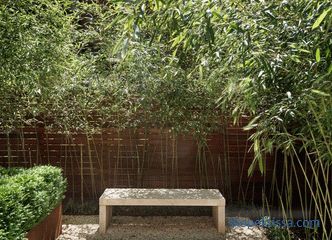
zone It might be interesting! In article on the following link read about the device and lawn care.
-
Lawn . In the absence of a large amount of high vegetation, the lawn becomes an important part of the design; therefore, a parterny lawn is laid out in a minimalist garden. It requires careful maintenance, but forms a denser carpet and therefore looks more effective. Modern trends allow some changes in the garden in the style of minimalism: the landscape design of your garden can do without a green lawn. Stone lawn (the same gravel dumping) borrowed from the Japanese tradition (which does not contradict the idea of minimalism) can successfully play its role. If you live in a dry climate, you can decorate it with succulent plants.
About topiary in the following video:
-
Plants should not limit or overlap the space. For registration choose low-growing trees (birch, Japanese cherry), around which often arrange gravel or pebble dumping. Higher trees (blue spruce, thuja) are trying to be planted singly, mainly along the edge of the territory.
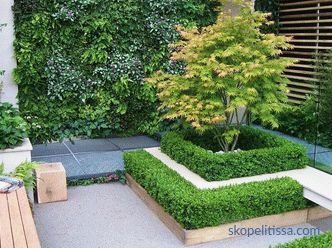
-
Flower plantings dull, often monochrome; plants with bright flowers (irises, chrysanthemums, Rogers) are planted accented, one or two species, using the method of repetition. A popular decoration method is container compositions consisting of volumetric geometric shaped containers.
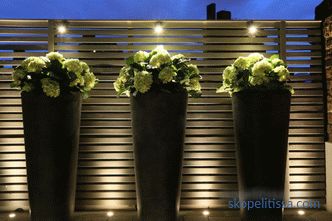
It can be interesting! In the article On the following link, read about the criteria for choosing garden lamps.
-
Vertical gardening is a device convenient for a small space, which allows you to hide it from your eyes. For vertical gardening suitable plants with a restrained texture: ivy, hops, girlish grapes.
-
A characteristic feature of the style is monocultural plantings when the composition contains one or two kinds of plants. Grasses with their inconspicuous colors and a variety of textures, ferns, mosses and groundcover species are widely used.
About the high-tech garden visualization in the following video:
Minimalism today
During the 20th century, European minimalism was enriched with the ideas of other cultures. Today, in addition to the traditional trend, there are other areas of minimalist design:
-
Scandinavian . Design with a bias in environmental friendliness. In the Scandinavian tradition to consider the garden as a continuation of the surrounding nature. Here, natural materials are more appreciated and widely used: raw boulders and dead wood, from which garden furniture is made. Of the plants in particular honor conifers.
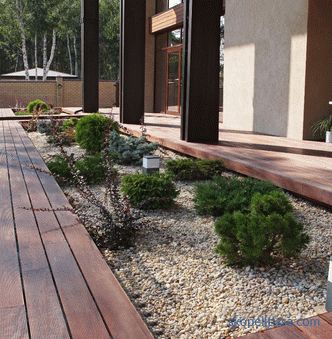
-
Japanese . The design is tied to the traditions of not only minimalism, but also symbolism; The goal of Japanese design is to achieve natural harmony in the combination of four material and one spiritual element. One of the main elements in the Japanese garden is a stone. This explains the mandatory presence, if not of a rock garden, then perhaps of a stone placer of a dry stream, a paved path made of natural stone or stone dumping.

-
Hi-tech . The conditional name for the industrial direction, as well as possible fits into the idea of minimalism. In contrast to the Japanese garden with its asymmetry, the layout of the high-tech to regularity (orderliness). A good addition is industrial-style furniture, chromed lamps of strict forms, flower containers without unnecessary details.
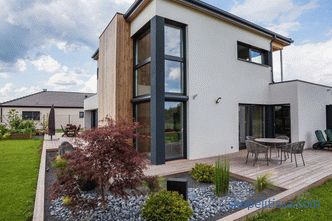
It might be interesting! In the article on the following link read about the cottage in the Art Nouveau style on the ocean.
Conclusion
Creating a minimalist landscape is not as easy as it may seem at first glance. The style is not based on cost savings (it may suddenly be more costly than expected); his charm is the ability to create harmony with a minimum of detail.
All types of style are successfully applied on modern suburban areas of any shape and topography. In order for the minimalist landscape to please the eye, garden architectural elements must be executed immaculately. Especially strong effect is obtained when the architecture of the buildings on the site is in harmony with the selected design.
Rate this article, we tried for you
